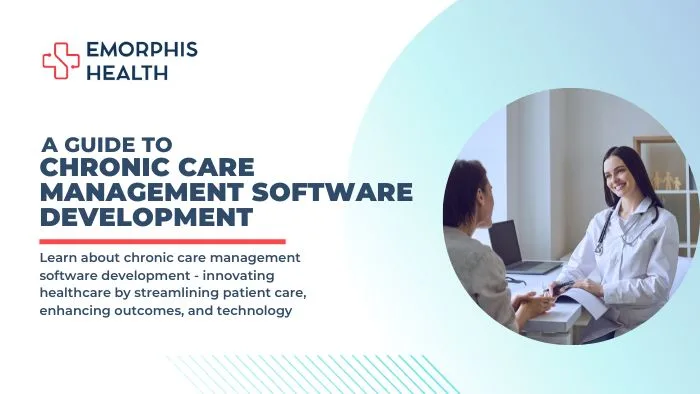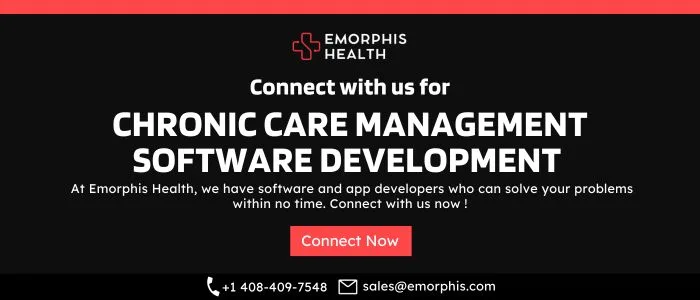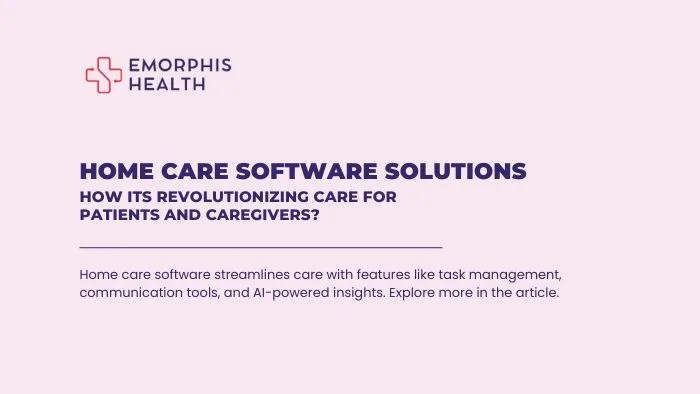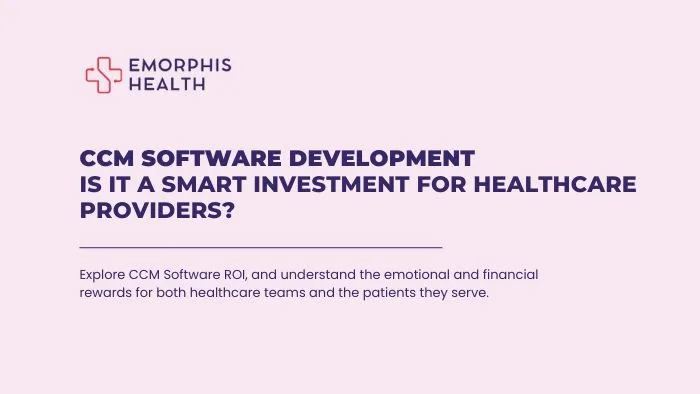Introduction
See Contents
Today, chronic care management software has emerged as a crucial tool for improving patient outcomes and enhancing care coordination. Let us explore the world of chronic care management software development, shedding light on its significance and the various aspects involved.
Understanding Chronic Care Management
Chronic medical conditions, such as diabetes, hypertension, and heart disease, affect millions of people worldwide. These conditions require ongoing, comprehensive care, which can be challenging to manage effectively. This is where chronic care management software steps in.
Chronic Care Management Software Development: A Beacon of Hope
The development of chronic care management software (CCM software) is a beacon of hope for both healthcare providers and patients. It facilitates the seamless management of chronic conditions by automating various aspects of care.
CCM software is specifically designed to support the diverse needs of patients with chronic conditions and healthcare professionals responsible for their care. It combines technology, medical expertise, and patient engagement to create a holistic approach to chronic disease management.
The Role of Care Management Software
Care management software is at the heart of this solution, serving as the foundation upon which effective chronic care management is built. It empowers healthcare providers with the tools and capabilities necessary to coordinate care for patients with chronic illnesses.
Through the meticulous development of care management software, healthcare teams can better organize patient information, design customized care plans, and streamline communication among team members. This improves the quality of care and also enhances the overall patient experience.
Chronic care management software development is a dynamic process that continues to evolve as new technologies and healthcare practices emerge. This ensures that the software remains relevant and effective in an ever-changing healthcare landscape.
In the next section, we’ll delve deeper into the key features that make CCM software an indispensable part of modern healthcare.
Key Features of CCM Software
Chronic care management software development incorporates a range of essential features, each playing a crucial role in the successful management of chronic conditions. Let’s check the features in detail.
A. Patient Information Management
CCM software acts as a secure repository for patient information. It includes medical histories, treatment plans, and contact details. This centralization of data ensures that healthcare providers have a comprehensive understanding of each patient’s health journey.
B. Care Plans
Within the software, healthcare providers can create and manage individualized care plans. These plans outline specific tasks, goals, and interventions tailored to each patient’s unique needs. This feature promotes a personalized approach to care.
C. Care Coordination
Effective care coordination is critical in managing chronic conditions. CCM software streamlines communication and collaboration among healthcare professionals. It ensures that the entire care team is aligned, reducing the risk of miscommunication and errors.
D. Remote Monitoring
Some chronic conditions require ongoing monitoring of vital signs, blood glucose levels, or other metrics. CCM software can integrate with remote monitoring devices, allowing for real-time data collection. This feature is especially valuable for patients who need continuous tracking.
E. Medication Management
Managing medications is a fundamental aspect of chronic care. The software includes features for medication reminders, prescription management, and adherence tracking. Patients and providers can work together to ensure that medications are taken as prescribed.
F. Patient Engagement
Engaging patients in their own care is vital for long-term success. CCM software provides tools for patient education, secure messaging, and appointment scheduling. This keeps patients informed and actively involved in managing their health.
G. Billing and Reimbursement
To support healthcare providers in offering chronic care management services, the software includes features for tracking and billing these services. This ensures that providers are appropriately reimbursed for their efforts.
H. Reporting and Analytics
Data is a powerful tool in healthcare. Chronic care management software generates reports and provides analytics to help providers assess the effectiveness of their care plans. It allows for data-driven decisions and adjustments.
I. Compliance and Regulatory Support
Healthcare regulations, such as HIPAA, are critical in ensuring patient data privacy and security. CCM software is designed to meet these regulatory requirements, giving both providers and patients confidence in the system’s security.
J. Telehealth Integration
Given the rise of telehealth, many CCM software solutions can seamlessly integrate with telehealth platforms. This integration enables virtual consultations and follow-ups, making it easier for patients to access care from the comfort of their homes.
K. Electronic Health Records (EHR) Integration
Integration with EHR systems is another crucial aspect of CCM software. It enables the sharing of patient data and health records among different healthcare providers, promoting continuity of care.
Each of these features is a building block in the development of CCM software. Together, they create a comprehensive solution that enhances the quality of care for individuals with chronic conditions. In the next section, we will explore the benefits that these features bring to patients and healthcare providers.
Benefits of Chronic Care Management Software
The development and implementation of chronic care management software offer a wide range of advantages for both healthcare providers and patients. Let’s delve into these benefits:
1. Improved Patient Outcomes
One of the most significant advantages of this software is its positive impact on patient outcomes. With features like care plans, medication management, and remote monitoring, patients receive more consistent and tailored care. This, in turn, leads to better disease management, reduced complications, and improved overall health.
2. Enhanced Care Coordination
CCM software fosters better collaboration among healthcare providers. Care coordination is streamlined, allowing various members of the healthcare team to work together seamlessly. This ensures that patients receive a well-coordinated, holistic approach to their care.
3. Cost Savings
Effective management of chronic conditions can lead to cost savings for both patients and healthcare systems. By proactively managing chronic illnesses and preventing complications, the software reduces the need for expensive emergency treatments and hospitalizations.
4. Billing and Reimbursement Opportunities
Services related to chronic care management are billable under certain healthcare reimbursement models. The software helps healthcare providers track and bill for these services accurately, ensuring that they are properly compensated for their efforts in managing chronic conditions.
5. Enhanced Patient Experience
Patients benefit from CCM software through improved engagement and convenience. Features like patient engagement tools, telehealth integration, and secure messaging make it easier for patients to communicate with their care team, access educational resources, and schedule appointments.
6. Data-Driven Decision-Making
The reporting and analytics capabilities of the software provide valuable insights into patient progress and the effectiveness of care plans. Healthcare providers can use this data to make informed decisions and fine-tune care strategies.
7. Prevention of Hospital Readmissions
Effective chronic care management helps prevent hospital readmissions, a common issue among individuals with chronic conditions. By closely monitoring and managing these patients, the software reduces the risk of recurring hospital stays.
These benefits collectively contribute to an improved quality of life for patients with chronic conditions and a more efficient healthcare system. CCM software is not just a technological tool; it is a catalyst for positive change in the way chronic diseases are managed.
As this software continues to evolve and adapt to the changing healthcare landscape, it is essential to understand the development process and the challenges associated with it. In the next section, we will explore the stages of chronic care management software development and the potential obstacles developers may encounter.
Chronic Care Management Software Development Process
The development of chronic care management software is a multi-faceted process, involving several key stages. Each stage plays a critical role in creating a reliable and effective system.
Step 1. Needs Assessment
The development journey begins with a comprehensive needs assessment. Developers work closely with healthcare providers to understand the specific requirements of the care management software. This involves identifying the chronic conditions to be addressed, the desired features, and the intended user experience.
Step 2. Design and Prototyping
Once the needs are defined, the software development team creates a detailed design and prototypes. These serve as blueprints for the software’s user interface, functionality, and data structure. Prototyping allows for early testing and refinement of the software’s look and feel.
Step 3. Development and Coding
The actual development phase involves writing the code for the software. Developers use the designs and prototypes as a guide to build the system’s core functionality. This phase requires a combination of technical expertise and an understanding of healthcare processes.
Step 4. Testing and Quality Assurance
Rigorous testing is essential to ensure that the software functions correctly and is free of errors. Quality assurance teams conduct various tests, including functional, performance, and security testing, to identify and address any issues.
Step 5. Deployment and Integration
Once the software passes testing, it is deployed in healthcare settings. Integration with existing systems, such as electronic health records (EHRs) and telehealth platforms, is a critical step. The software must seamlessly interact with other healthcare technologies.
Each of these stages requires meticulous attention to detail and collaboration between software developers, healthcare providers, and end-users. Successful chronic care management software development hinges on meeting the specific needs of healthcare organizations and the patients they serve.
Challenges in CCM Software Development
While the development of chronic care management software holds promise, it also presents several challenges that developers must address:
- Data Security and Privacy: Protecting patient data is important. Developers must ensure that the software complies with healthcare regulations like HIPAA to safeguard sensitive health information.
- Interoperability: Achieving interoperability with other healthcare systems and devices is essential for seamless care coordination. Developers face the challenge of making the software compatible with various technologies.
- Regulatory Compliance: Healthcare is subject to strict regulations and compliance requirements. Adhering to these rules is a significant challenge in software development. Compliance with evolving regulations is an ongoing concern.
- User Adoption: To be effective, CCM software must be embraced by healthcare providers and patients. Developers must design user-friendly interfaces and provide adequate training to ensure user adoption.
Overcoming these challenges requires a combination of technical expertise and a deep understanding of healthcare processes and regulations. Successful software development not only addresses these issues but also positions the software as a valuable asset in the management of chronic conditions.
In the following section, we will explore the evolving trends in chronic care management software development, reflecting the changing landscape of healthcare.
Trends in Chronic Care Management Software Development
The landscape of healthcare is continually evolving, and CCM software is no exception. Several trends in software development are shaping the way chronic conditions are managed and monitored. Let’s explore these trends:
- Telehealth Integration: The integration of telehealth capabilities within CCM software is a prominent trend. Telehealth offers patients the convenience of remote consultations with healthcare providers. This trend not only supports patient engagement but also addresses access barriers, making care more accessible.
- AI and Machine Learning: Artificial intelligence (AI) and machine learning are being incorporated into CCM software. These technologies can analyze patient data, predict health trends, and automate routine tasks, such as flagging critical changes in patient health status.
- Mobile Applications: The use of mobile applications is on the rise. Mobile apps allow patients to monitor their health, receive reminders, and communicate with their care team using their smartphones or tablets. Mobile solutions increase patient engagement and accessibility.
- EHR Integration: Seamless integration with electronic health records (EHRs) is becoming a standard requirement. This integration ensures that patient data is consistent and easily accessible across various healthcare settings, streamlining the exchange of critical information.
- Remote Monitoring Devices: CCM software is increasingly designed to interface with a variety of remote monitoring devices. These devices collect data on vital signs, glucose levels, and other health metrics, offering real-time insights to both patients and providers.
These trends reflect a commitment to delivering more patient-centric care and leveraging technology to improve the management of chronic conditions. By embracing these developments, healthcare providers can further enhance the effectiveness and efficiency of their care delivery.
In the next section, we will explore the future of CCM software solutions.
Future Outlook
The future of chronic care management software holds great promise, driven by ongoing innovations and the evolving healthcare landscape. Here, we explore what lies ahead:
a. Evolving Healthcare Landscape
The healthcare industry is continually evolving, influenced by changing demographics, emerging health challenges, and advancements in medical technology. CCM software will adapt to these changes, remaining a vital component in the healthcare ecosystem.
b. Opportunities for Innovation
The need for innovation in healthcare remains high. Chronic care management software developers will have opportunities to create new features, enhance user experiences, and integrate emerging technologies, such as wearables and the Internet of Things (IoT), to further improve patient care.
c. Patient-Centric Care
The focus on patient-centric care is set to intensify. CCM software will place even more emphasis on engaging patients in their own care, providing them with tools to monitor their health, access educational resources, and communicate effectively with their healthcare teams.
d. Data-Driven Decision-Making
The role of data in healthcare will continue to expand. Chronic care management software will offer more robust analytics and data visualization tools, enabling healthcare providers to make data-driven decisions that lead to better patient outcomes.
e. Global Adoption
As healthcare systems around the world recognize the benefits of chronic care management, the global adoption of CCM software is likely to increase. Developers will need to consider international standards and regulations as they expand their reach.
f. Interoperability Solutions
Addressing interoperability challenges will remain a priority. Developers will focus on creating solutions that seamlessly connect with various EHR systems, telehealth platforms, and remote monitoring devices, ensuring a cohesive approach to patient care.
The future of CCM software is marked by a commitment to innovation, patient empowerment, and improved healthcare delivery. As technology continues to advance and healthcare practices evolve, chronic care management software will play an increasingly pivotal role in managing chronic conditions and enhancing patient well-being.
Conclusion
Chronic care management software development is a dynamic field that addresses the evolving needs of healthcare providers and patients dealing with chronic medical conditions. The software’s key features, benefits, development process, and emerging trends all contribute to a more efficient and patient-centered approach to managing chronic diseases.
As this technology continues to evolve, it promises to be an indispensable tool in the ever-changing landscape of healthcare. By addressing challenges, embracing innovation, and remaining patient-focused, CCM software is poised to make a lasting and positive impact on the quality of care provided to individuals with chronic conditions.
In conclusion, chronic care management software is not just a software solution; it’s a driving force behind the future of healthcare, improving patient outcomes and enhancing the lives of those managing chronic conditions.
Connect with us for healthcare software product engineering.






